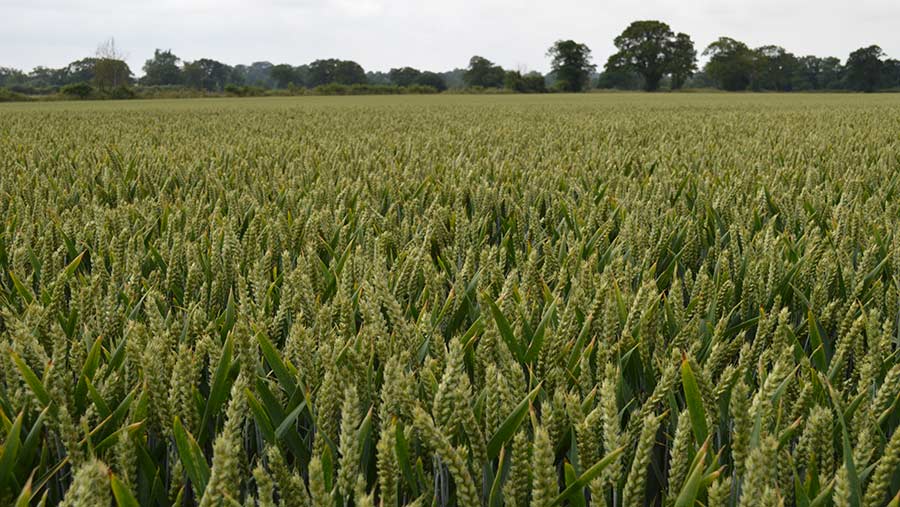Durham grower turns to ‘regen’ wheat variety
 Typhoon wheat © MAG/David Jones
Typhoon wheat © MAG/David Jones Durham grower Philip Vickers has turned to a relatively new feed wheat variety to help build a more sustainable regenerative cropping system involving direct-drilling and reduced synthetic crop inputs.
Philip, farm manager on Raby Estates, grew 32ha of Typhoon, and after an average yield at harvest 2023 of 9.5t/ha, together with its ease of management, he plans to drill 100ha this coming season.
See also: Why it may be time to drop susceptible winter wheat varieties
He was looking for a variety that suited early direct-drilling and could allow him to trim back on fungicides and nitrogen fertiliser. The estate generally grows 500-600ha of Group 4 hard-milling feed wheats.
“We’re trying to move away from growing high-input varieties, so are primarily looking for those that offer a robust disease package, good standing power and suitability for our direct-drilling system,” says Philip.

Phil Vickers, Raby Estates © Raby Estates
High septoria pressure
The variety showed a yield range of 9.4-9.6t/ha in a difficult 2023 season with exceptionally high septoria pressure and wet early spring weather on the estate, which largely runs between Piercebridge and Staindrop, just north-west of Darlington.
In autumn 2022, the variety was direct-drilled in mid-September as a first wheat after oilseed rape, and seed rates were kept relatively high at about 300 seeds/sq m to counter the slightly lower establishment experienced when direct-drilling.
“Direct-drilling in northern England is not something you want to be doing into November, so I also look for varieties that suit the early drilling slot,” he says.
All wheat received a base application of phosphate and potash, plus up to 170kg/ha of nitrogen in the spring, applied as three splits – the first as granular urea and then followed by two liquid nitrogen applications.
“We have been reducing nitrogen use significantly in recent years, but in contrast to conventional thinking, some crop yields have gone up in that period,” says Philip.
Quick to establish
The variety established quickly in the autumn, then got away well in the spring, and was relatively early to harvest, just behind the variety Graham.
Although it did establish quickly, the variety did not get too large, unlike some others that continued to tiller through a mild autumn and became much harder to manage with plant growth regulators and fungicides in the spring.
Strong genetic septoria resistance is a must-have for all winter wheat varieties grown on the estate, and Philip generally looks for varieties with a AHBD Recommended List (RL) score of at least six, and Typhoon has a rating of 7.3, in a 1-9 range where 1 is susceptible and 9 shows good resistance.
Although all wheats received the farm’s standard four-spray fungicide programme, Philip was able to reduce spray rates by 10-15% on the Typhoon due to its robust disease profile.
“We still didn’t see any disease of significance at all last season, even though there was very high septoria pressure, which caused some other varieties to struggle,” he says.
Good fit for regen systems
Ron Granger, arable technical manager at Typhoon’s breeder Limagrain, says the variety is well suited to strip tillage/direct-drilling, regenerative crop establishment systems, that often feature wider crop rows.
The variety’s growth habit means plants sit prostrate with slower growth through the winter and into spring, which is ideal for those direct-drilling earlier in the autumn and who do not want a variety that races off too quickly, he says.
It is a high tillering variety that has the capacity to use the space between the wider rows, often found with some direct-drilling equipment, and Ron says the variety seemed to suit the wider row spacings used at Raby.
The variety is a good fit for those looking for flexibility with crop protection inputs due to its strong standing power and disease resistance – reflected by its high untreated fungicide yield of 92 in the AHDB RL, he adds.
“It’s a high-yielding, consistent and resilient variety, that delivers across seasons and rotations,” says Ron.
The variety was added to the AHDB 2022-23 RL in late 2021 at the same time as other hard-milling Group 4 feed wheats such as Dawsum and Champion were added.
Philip Vickers is a Farmers Weekly Transition Farmer, who is sharing his journey as he works to secure a more sustainable future for his business. For more details, visit our Transition hub.

